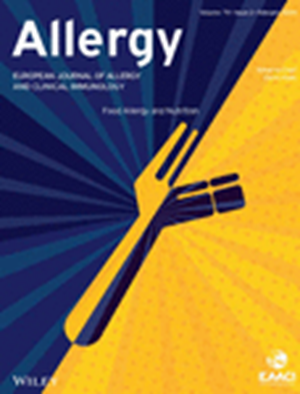CT - P39与参考Omalizumab治疗慢性自发性荨麻疹的比较:来自双盲、随机、主动对照的3期研究结果
IF 12.6
1区 医学
Q1 ALLERGY
引用次数: 0
摘要
本研究比较了CT - P39(一种omalizumab生物类似药)和欧盟批准的参考药物omalizumab (ref - OMA)在慢性自发性荨麻疹患者中的治疗等效性。方法:这项双盲、随机、主动对照的3期研究(NCT04426890)包括两个12周的治疗期(TPs)。在TP1中,患者接受CT - P39 300 mg, ref - OMA 300 mg, CT - P39 150 mg或ref - OMA 150 mg。在TP2中,用ref - OMA 300 mg治疗的患者被重新随机分配到CT - P39 300 mg或ref - OMA 300 mg;最初随机分配到CT - P39 300 mg的患者继续该方案;最初随机分配到CT - P39或ref - OMA 150毫克的患者接受300毫克剂量的相同药物。评估CT - P39 300 mg和ref - OMA 300 mg治疗等效性的主要终点是第12周周瘙痒严重程度评分(ISS7)较基线的变化。结果TP1随机纳入619例患者(CT‐P39 300 mg, n = 204;ref‐OMA 300 mg, n = 205;CT‐P39 150 mg, n = 107;ref‐OMA 150 mg, n = 103)。在ISS7第12周时,CT - P39 300 mg和ref - OMA 300 mg的平均基线变化证明是等效的;置信区间(CI)在预定义的等效范围内:整体分析:治疗差异0.77,95% CI -0.37至1.90;美国分析:治疗差异0.70,90% CI -0.22至1.63。经历≥1个治疗相关不良事件的患者比例在各组间具有可比性。在给定剂量水平下,两组间的次要疗效、生活质量、药代动力学、安全性和免疫原性结果具有可比性,没有明显的转换影响。结论CT - P39与ref - OMA疗效相当,安全性也相当。本文章由计算机程序翻译,如有差异,请以英文原文为准。
CT‐P39 Compared With Reference Omalizumab in Chronic Spontaneous Urticaria: Results From a Double‐Blind, Randomized, Active‐Controlled, Phase 3 Study
BackgroundThis study compared the therapeutic equivalence of CT‐P39 (an omalizumab biosimilar) and EU‐approved reference omalizumab (ref‐OMA) in patients with chronic spontaneous urticaria.MethodsThis double‐blind, randomized, active‐controlled Phase 3 study (NCT04426890) included two 12‐week treatment periods (TPs). In TP1, patients received CT‐P39 300 mg, ref‐OMA 300 mg, CT‐P39 150 mg, or ref‐OMA 150 mg. In TP2, patients treated with ref‐OMA 300 mg were rerandomized to CT‐P39 300 mg or ref‐OMA 300 mg; patients initially randomized to CT‐P39 300 mg continued this regimen; and patients initially randomized to CT‐P39 or ref‐OMA 150 mg received 300 mg dosing with the same drug. The primary endpoint for the assessment of therapeutic equivalence of CT‐P39 300 mg and ref‐OMA 300 mg was change from baseline in weekly itch severity score (ISS7) at week 12.ResultsIn TP1, 619 patients were randomized (CT‐P39 300 mg, n = 204; ref‐OMA 300 mg, n = 205; CT‐P39 150 mg, n = 107; ref‐OMA 150 mg, n = 103). Equivalence was demonstrated between CT‐P39 300 mg and ref‐OMA 300 mg for mean change from baseline in ISS7 at week 12; confidence intervals (CIs) were within predefined equivalence margins: global analysis: treatment difference 0.77, 95% CI –0.37 to 1.90; US analysis: treatment difference 0.70, 90% CI –0.22 to 1.63. The proportion of patients experiencing ≥ 1 treatment‐related adverse event was comparable across groups. Secondary efficacy, quality of life, pharmacokinetic, safety, and immunogenicity outcomes were comparable between groups at a given dose level, with no evident impact of switching.ConclusionsEquivalent efficacy was observed between CT‐P39 and ref‐OMA, with comparable safety also evident.
求助全文
通过发布文献求助,成功后即可免费获取论文全文。
去求助
来源期刊

Allergy
医学-过敏
CiteScore
26.10
自引率
9.70%
发文量
393
审稿时长
2 months
期刊介绍:
Allergy is an international and multidisciplinary journal that aims to advance, impact, and communicate all aspects of the discipline of Allergy/Immunology. It publishes original articles, reviews, position papers, guidelines, editorials, news and commentaries, letters to the editors, and correspondences. The journal accepts articles based on their scientific merit and quality.
Allergy seeks to maintain contact between basic and clinical Allergy/Immunology and encourages contributions from contributors and readers from all countries. In addition to its publication, Allergy also provides abstracting and indexing information. Some of the databases that include Allergy abstracts are Abstracts on Hygiene & Communicable Disease, Academic Search Alumni Edition, AgBiotech News & Information, AGRICOLA Database, Biological Abstracts, PubMed Dietary Supplement Subset, and Global Health, among others.
 求助内容:
求助内容: 应助结果提醒方式:
应助结果提醒方式:


